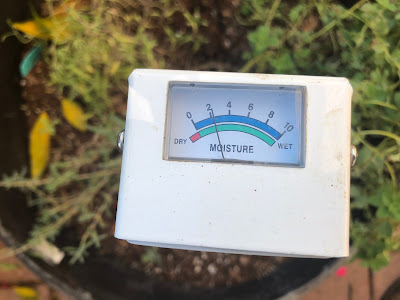

|
|
This moisture meter in a grow bag tells the story
of November: Mostly dry. (Photo: Kathy Morrison) |
One bomb cyclone is not enough to end a drought.
October’s deluge posted record one-day rain totals (including 5.41 inches at Sacramento Executive Airport), but a very dry November is putting that wet start to our rain year in perspective.
So far this month, we’ve received only .72 inches – about the same precipitation for November 2019 and November 2020. Normal for the month: 2 inches.
Our forecast for the remaining week (including Thanksgiving) looks dry, too. According to the National Weather Service, the next chance of rain won’t arrive until Dec. 1.
That’s after a soggy October in Sacramento that totaled 6.72 inches, more than four times average for that month.
Thanks to all that early rain, Sacramento is still in pretty good shape, water-wise, compared to where we stood in drought years 2019 and 2020. Sacramento Executive Airport has received 7.44 inches so far since our new rain year began Oct. 1. That’s 41% of our average total (18.1 inches) and more precipitation than we received in all of the previous rain year (6.61 inches) that ended Sept. 30.
Although that stormy October made quite a splash, winter is when nature really builds its moisture reserves with Sierra snowpack at higher elevations and slow-moving, soaking rain in the Valley.
Unfortunately, our long-range forecast looks pretty dry. According to the Old Farmer’s Almanac, our winter will be warmer and drier than average. Late December can expect some big storms, but January, February and March – usually our rainiest time of the year – will see lower than normal precipitation, perhaps 5 to 6 inches below normal.
With that dry forecast in mind, local water providers are still offering rebates and resources for water-efficient upgrades. Learn more at www.bewatersmart.info .
Comments
0 comments have been posted.Sacramento Digs Gardening to your inbox.
Food in My Back Yard Series
May 6: Maintain soil moisture with mulch for garden success
April 29: What's (already) wrong with my tomato plants?
April 22: Should you stock up on fertilizer? (Yes!)
April 15: Grow culinary herbs in containers
April 8: When to plant summer vegetables
April 1: Don't be fooled by these garden myths
March 25: Fertilizer tips: How to 'feed' your vegetables for healthy growth
March 18: Time to give vegetable seedlings some more space
March 11: Ways to win the fight against weeds
March 4: Potatoes from the garden
Feb. 25: Plant a fruit tree now -- for later
Feb. 18: How to squeeze more food into less space
Feb. 11: When to plant? Consider staggering your transplants
Feb. 4: Starting in seed starting
Sites We Like
Garden Checklist for week of May 4
Enjoy this spring weather – and get gardening!
* Plant, plant, plant! It’s prime planting season in the Sacramento area. Time to set out those tomato transplants along with peppers and eggplants. Pinch off any flowers on new transplants to make them concentrate on establishing roots instead of setting premature fruit.
* Direct-seed melons, cucumbers, summer squash, corn, radishes, pumpkins and annual herbs such as basil.
* Harvest cabbage, lettuce, peas and green onions.
* In the flower garden, direct-seed sunflowers, cosmos, salvia, zinnias, marigolds, celosia and asters. (You also can transplant seedlings for many of the same flowers.)
* Plant dahlia tubers. Other perennials to set out include verbena, coreopsis, coneflower and astilbe.
* Transplant petunias, marigolds and perennial flowers such as astilbe, columbine, coneflowers, coreopsis, dahlias, rudbeckia and verbena.
* Keep an eye out for slugs, snails, earwigs and aphids that want to dine on tender new growth.
* Feed summer bloomers with a balanced fertilizer.
* For continued bloom, cut off spent flowers on roses as well as other flowering plants.
* Add mulch to the garden to maintain moisture. Mulch also cuts down on weeds. But don’t let it mound around the stems or trunks of trees or shrubs. Leave about a 6-inch to 1-foot circle to avoid crown rot or other problems.